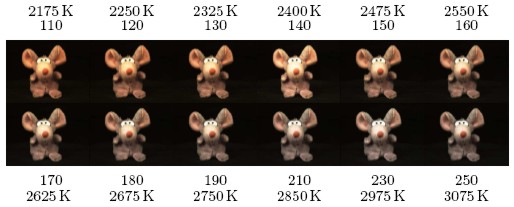
ALOI is a color image collection of one-thousand small objects, recorded for scientific purposes. In order to capture the sensory variation in object recordings, we systematically varied viewing angle, illumination angle, and illumination color for each object, and additionally captured wide-baseline stereo images. We recorded over a hundred images of each object, yielding a total of 110,250 images for the collection. See Technical Details for a description of the acquisition setup.
Details have been
published in: J. M. Geusebroek, G. J. Burghouts, and A. W. M. Smeulders,
The Amsterdam library of object images,
Int. J. Comput. Vision, 61(1), 103-112, January, 2005
(PDF).
Please consult the paper for all details on recording of the collection.
Illumination Direction is varied in 24 configurations:

Each object was recorded with only one out of five lights turned on,
yielding five different illumination angles (conditions l1-l5). By switching
the camera, and turning the stage towards that camera, the
illumination bow is virtually turned by 15 (camera c2) and 30 degrees (camera
c3), respectively. Hence, the aspect of the objects viewed by each
camera is identical, but light direction has shifted by 15
and 30 degrees in azimuth. In total, this results in 15 different
illumination angles.
Furthermore, combinations of lights were used to illuminate the
object. Turning on two lights at the sides of the object yielded
an oblique illumination from right (condition l6) and left (condition l7).
Turning on all lights (condition l8)
yields a sort of hemispherical illumination, although
restricted to a more narrow illumination sector than true
hemisphere. In this way, a total of 24 different illumination
conditions were generated, conditions c[1..3]l[1..8].
Illumination Color is varied in 12 configurations:

Each object was recorded in frontal view, with all five lamps turned on. Illumination color temperature is changed from 2175K to 3075K. Cameras were white balanced at 3075K, resulting in objects illuminated under a reddish to white illumination color, conditions i110, i120, ..., i250.
Object Viewpoint is varied from 72 directions:

The frontal camera was used to record 72 aspects of the objects by rotating the object in the plane at 5 degree resolution, conditions r0..r355. This collection is similar to the COIL collection.
Wide-baseline Stereo For 750 objects (objects 251--1000), we also
captured wide baseline stereo images:

By turning the object to view the second camera, a center image (configuration c), a right image (configuration r) and a left image (configuration l) could be made. The combination of left-center and center-right images yields two pairs of 15 degree baseline stereo, whereas the combination of the left-right pair yields a 30 degree baseline stereo pair.